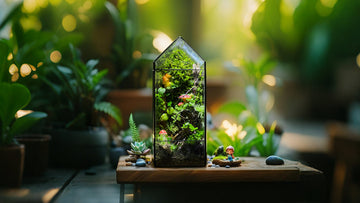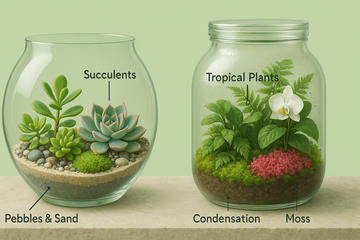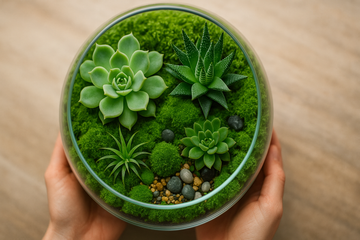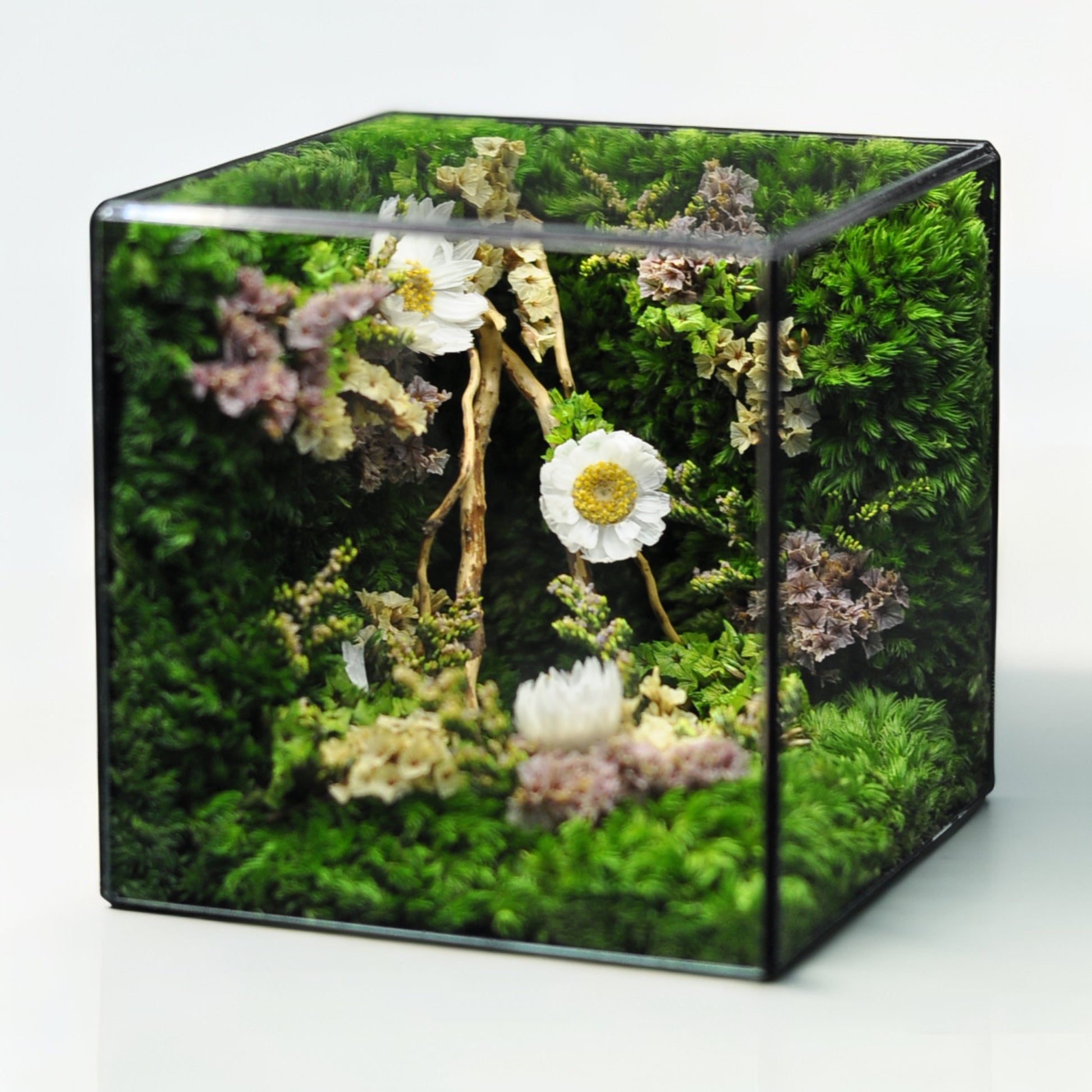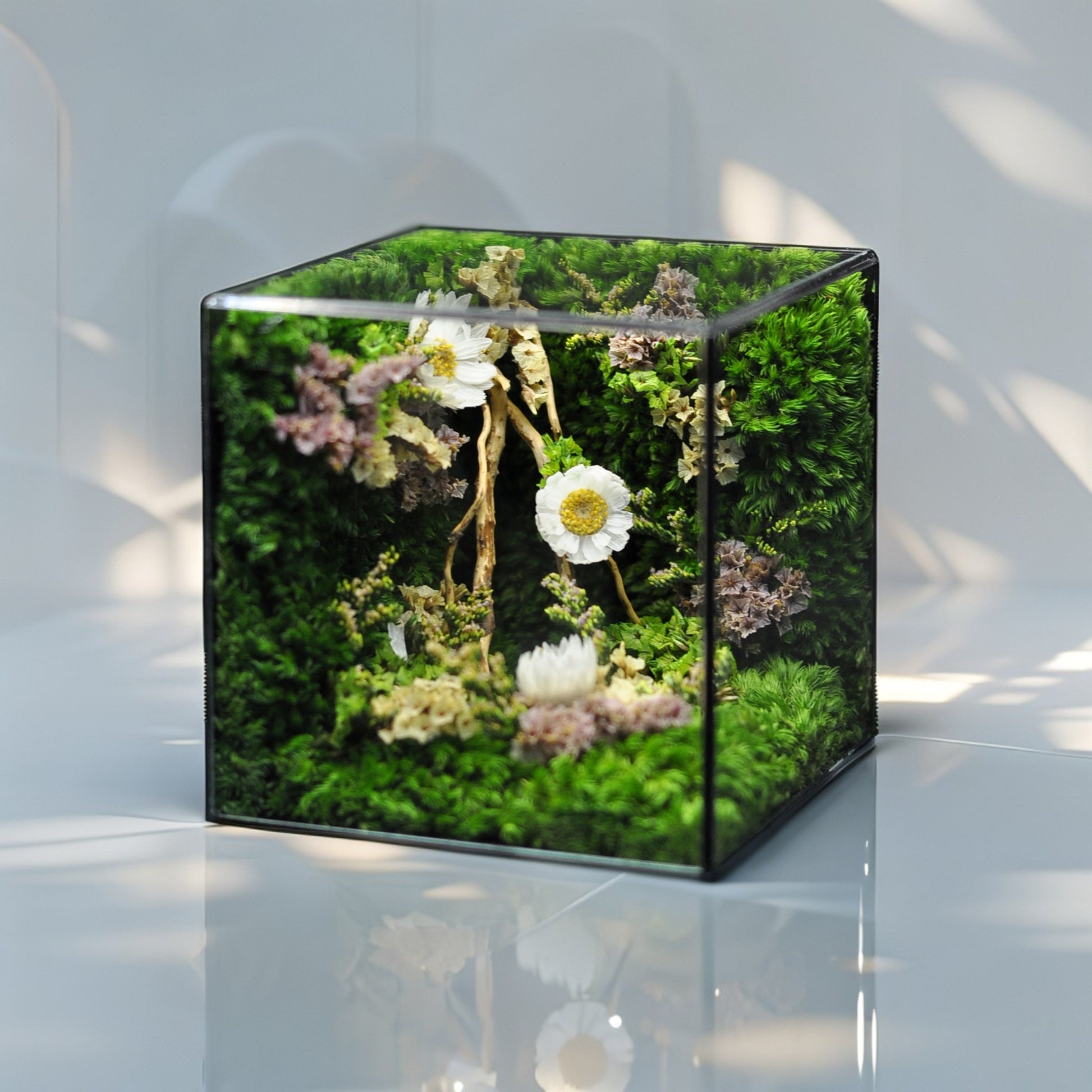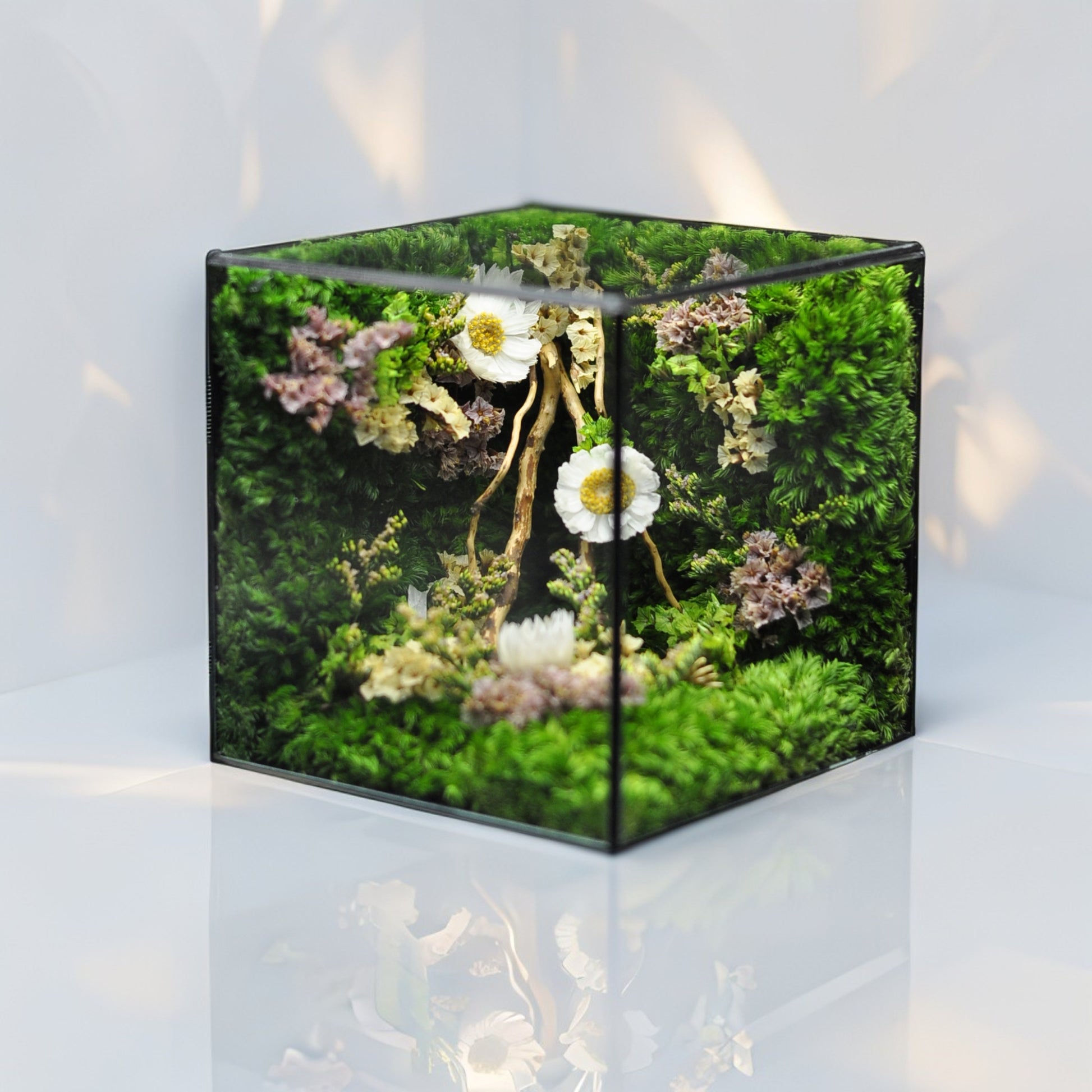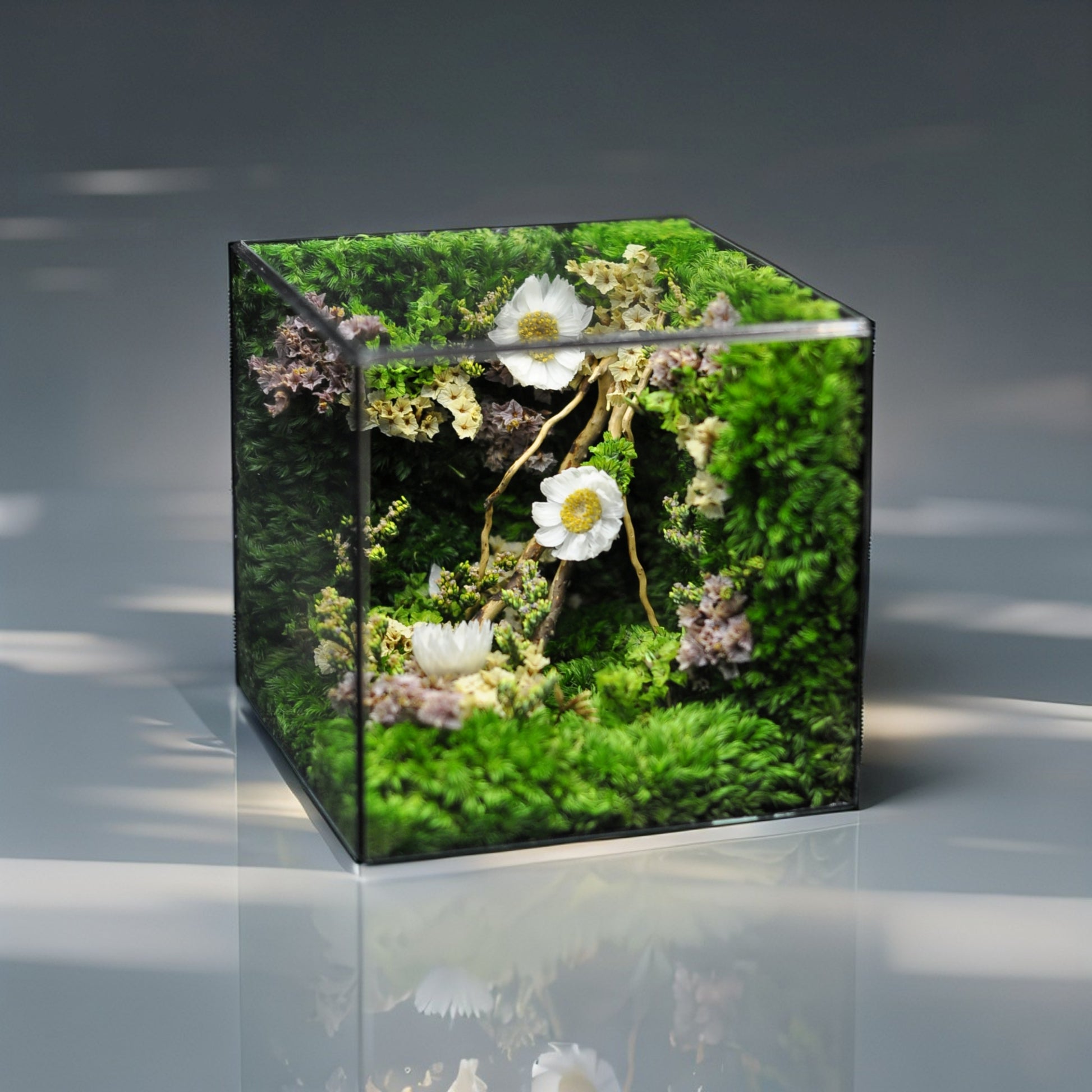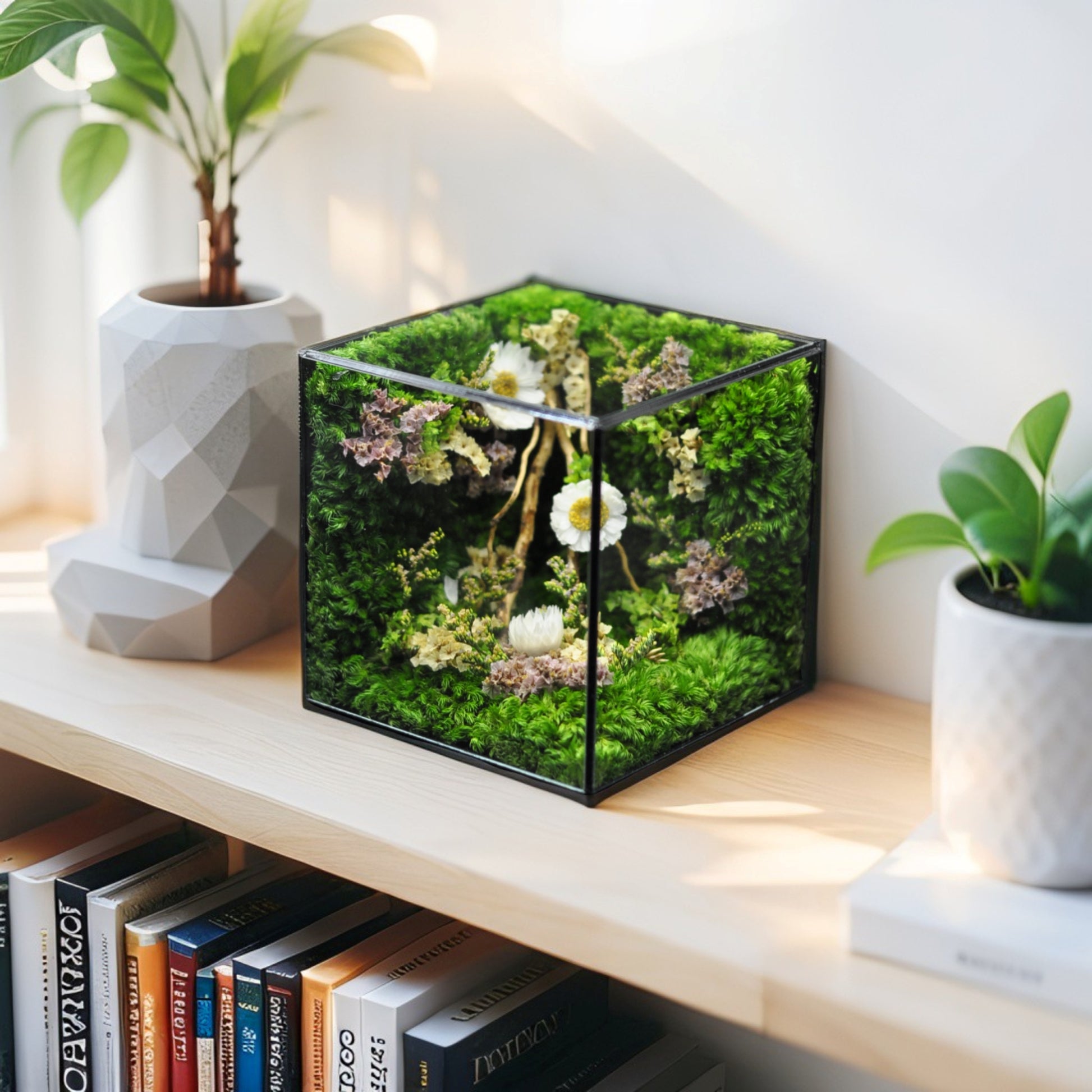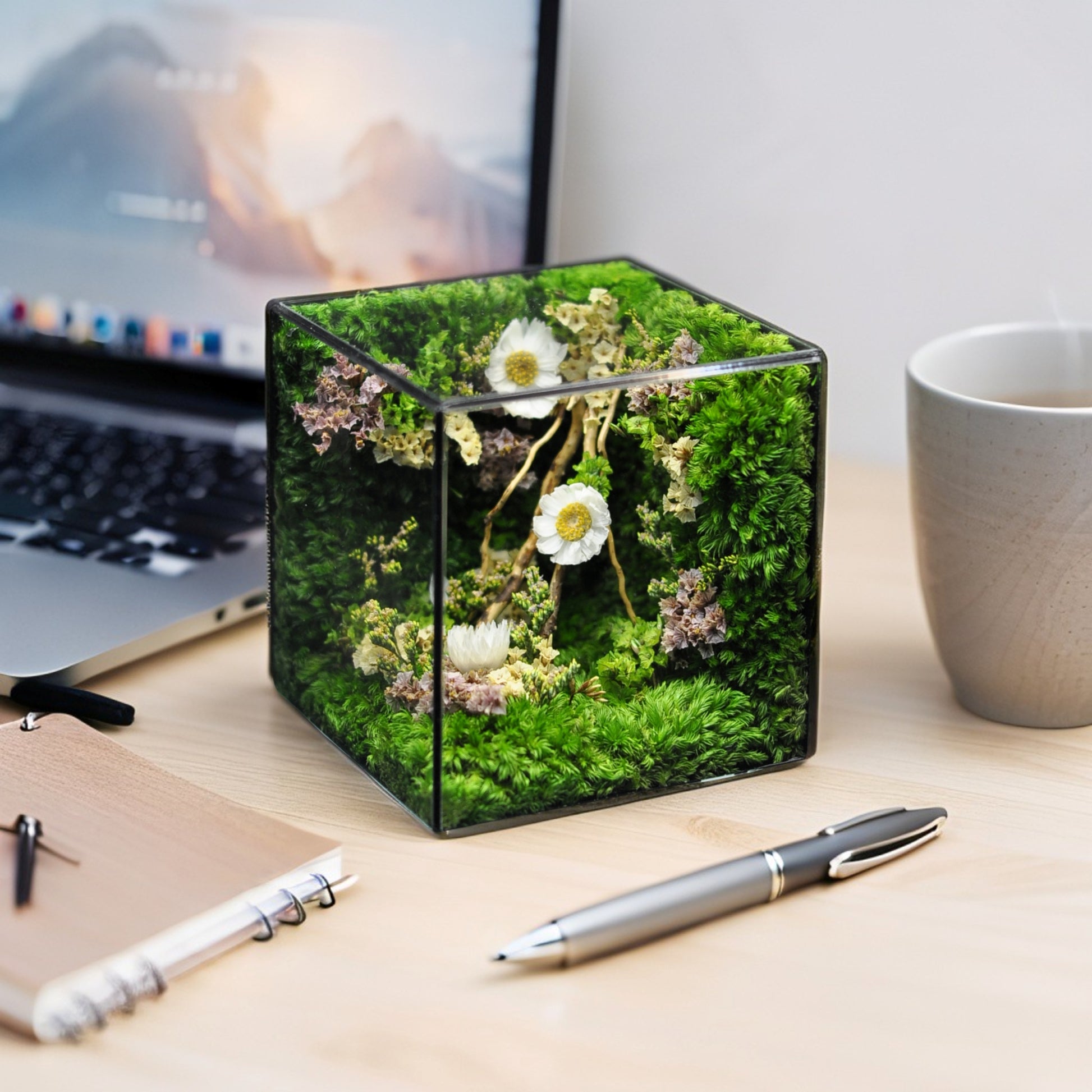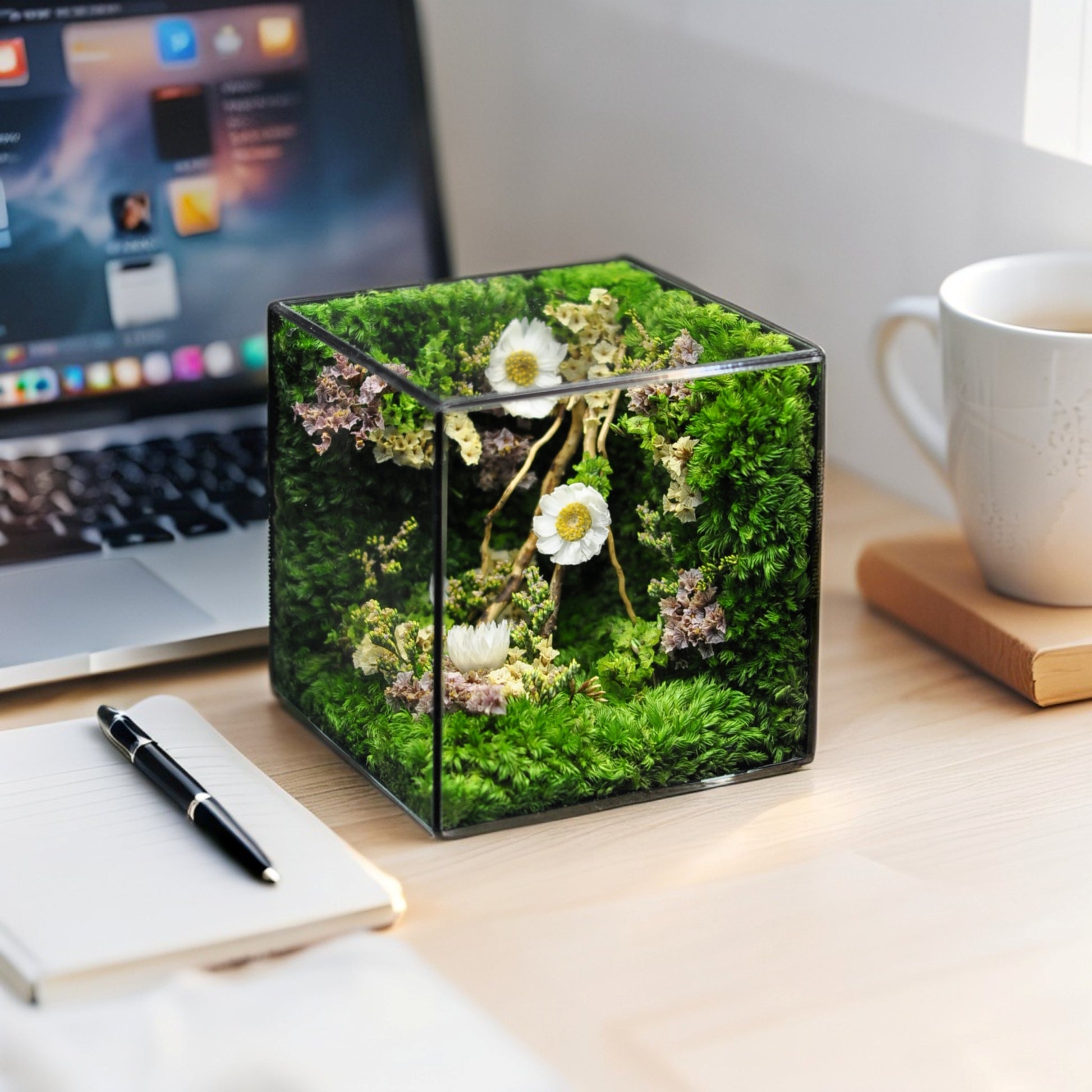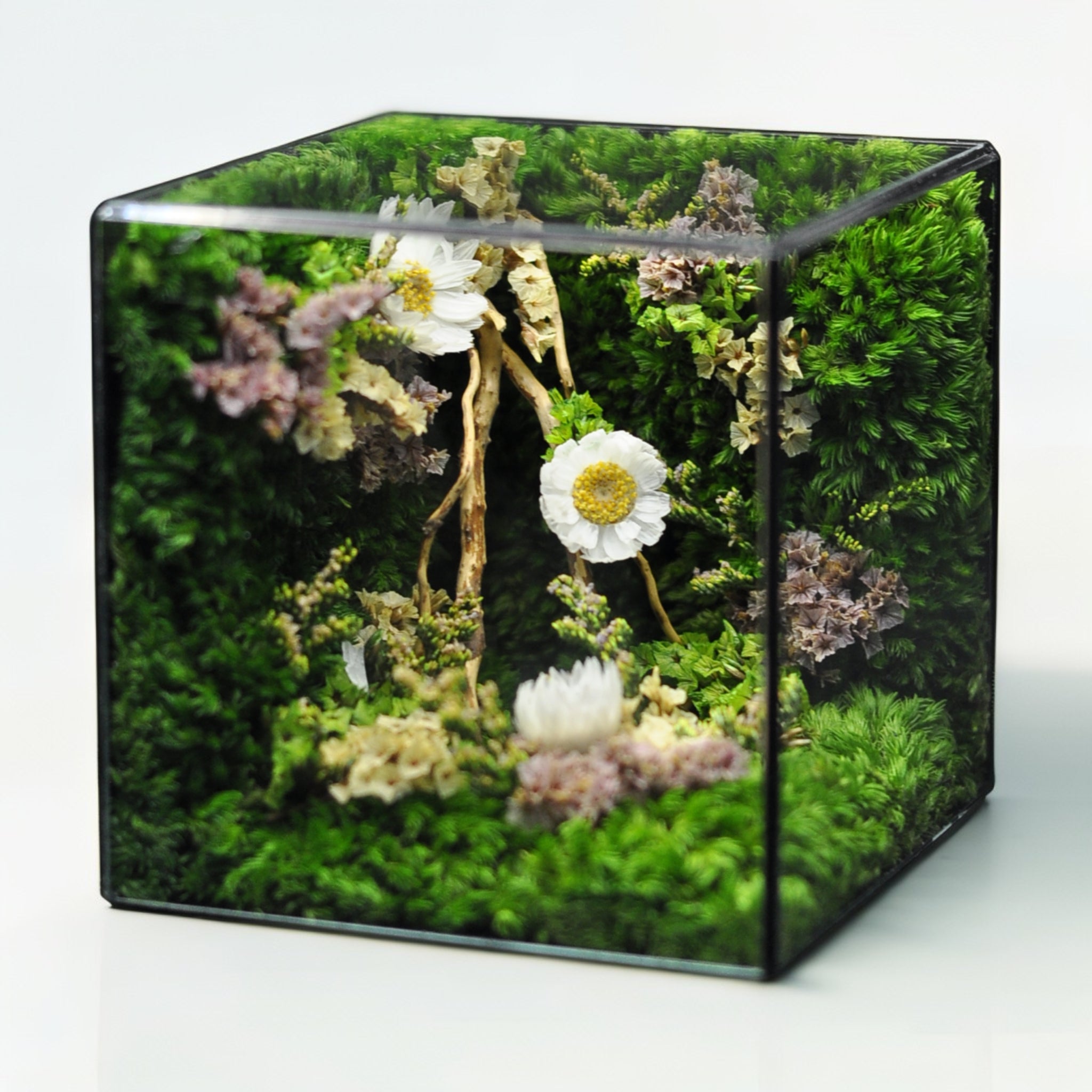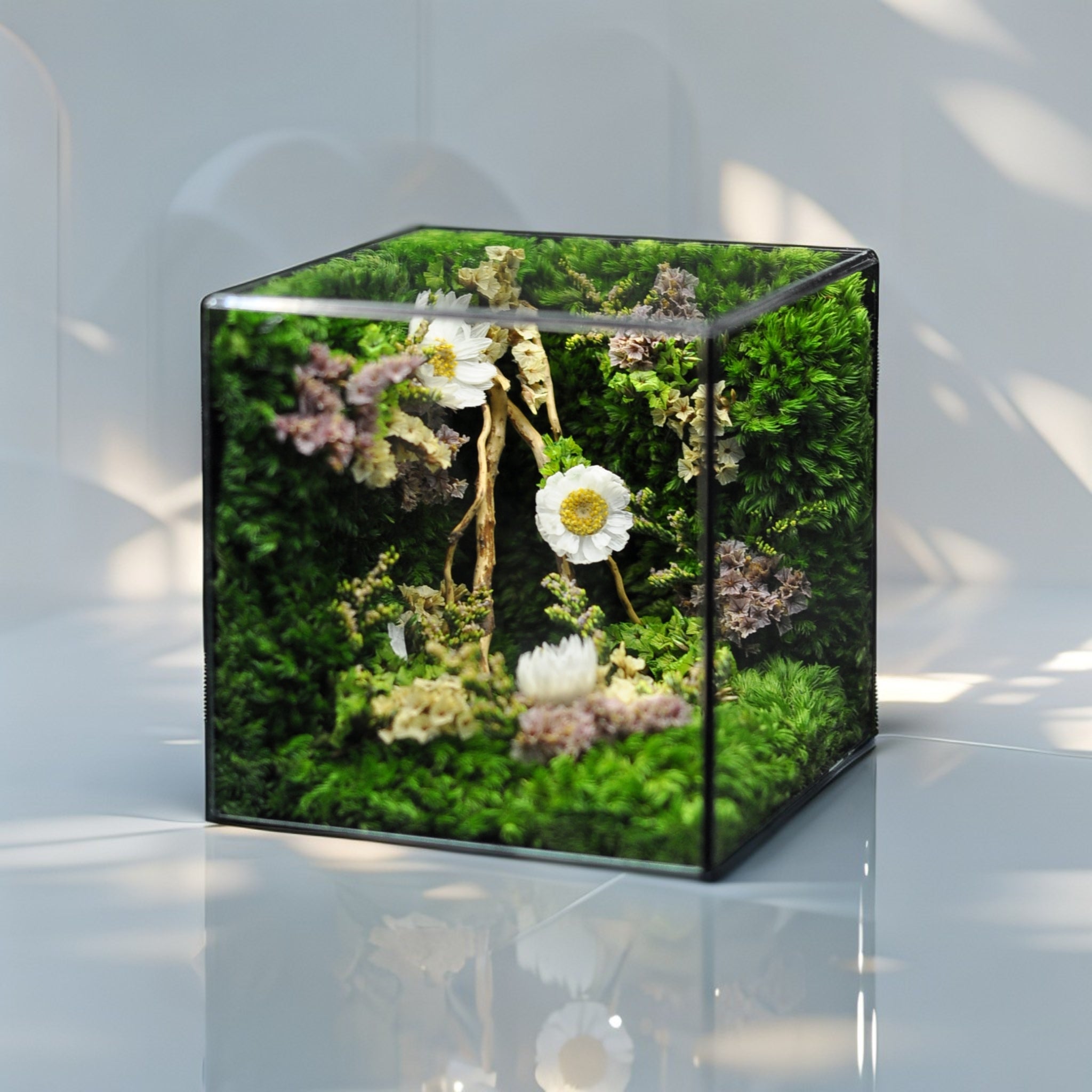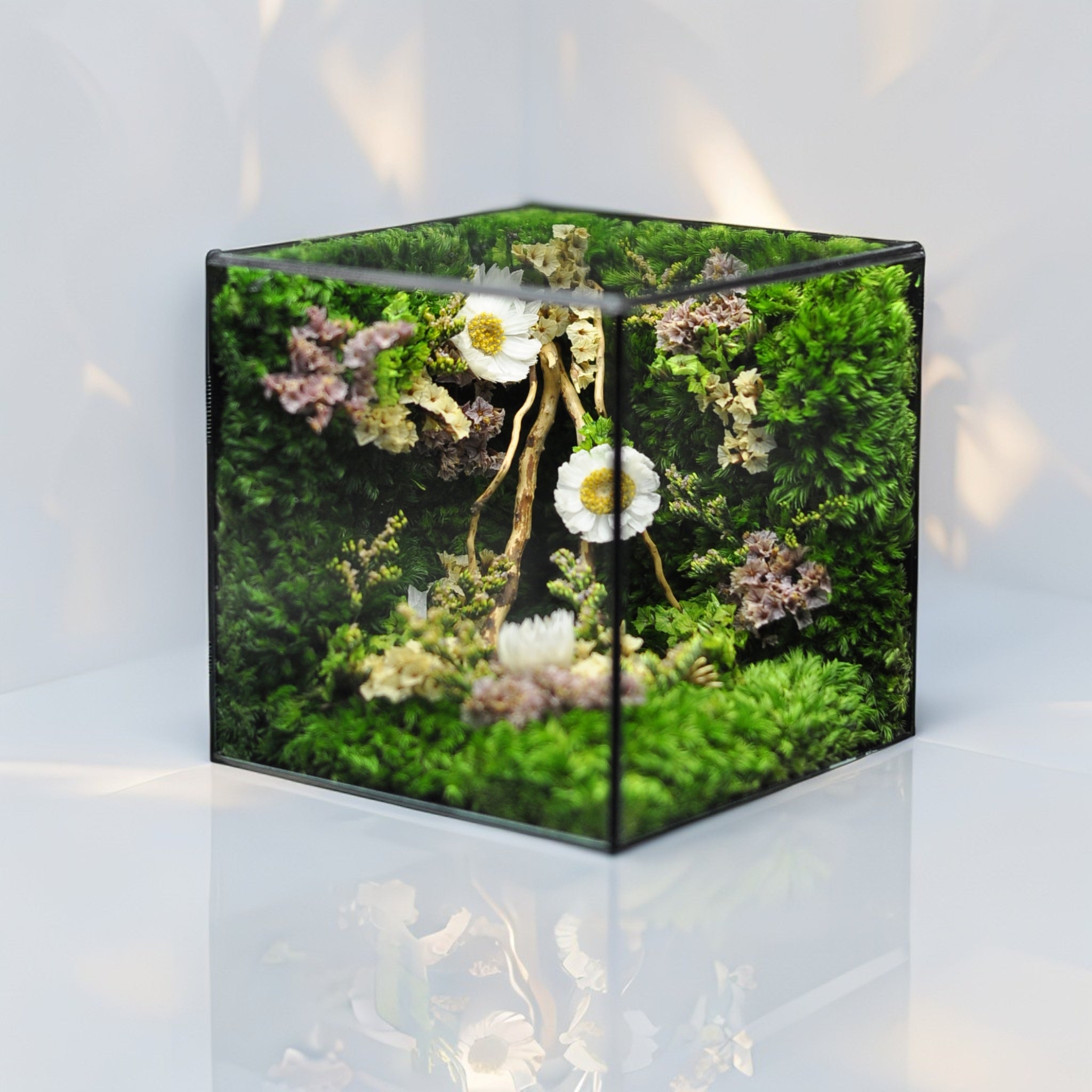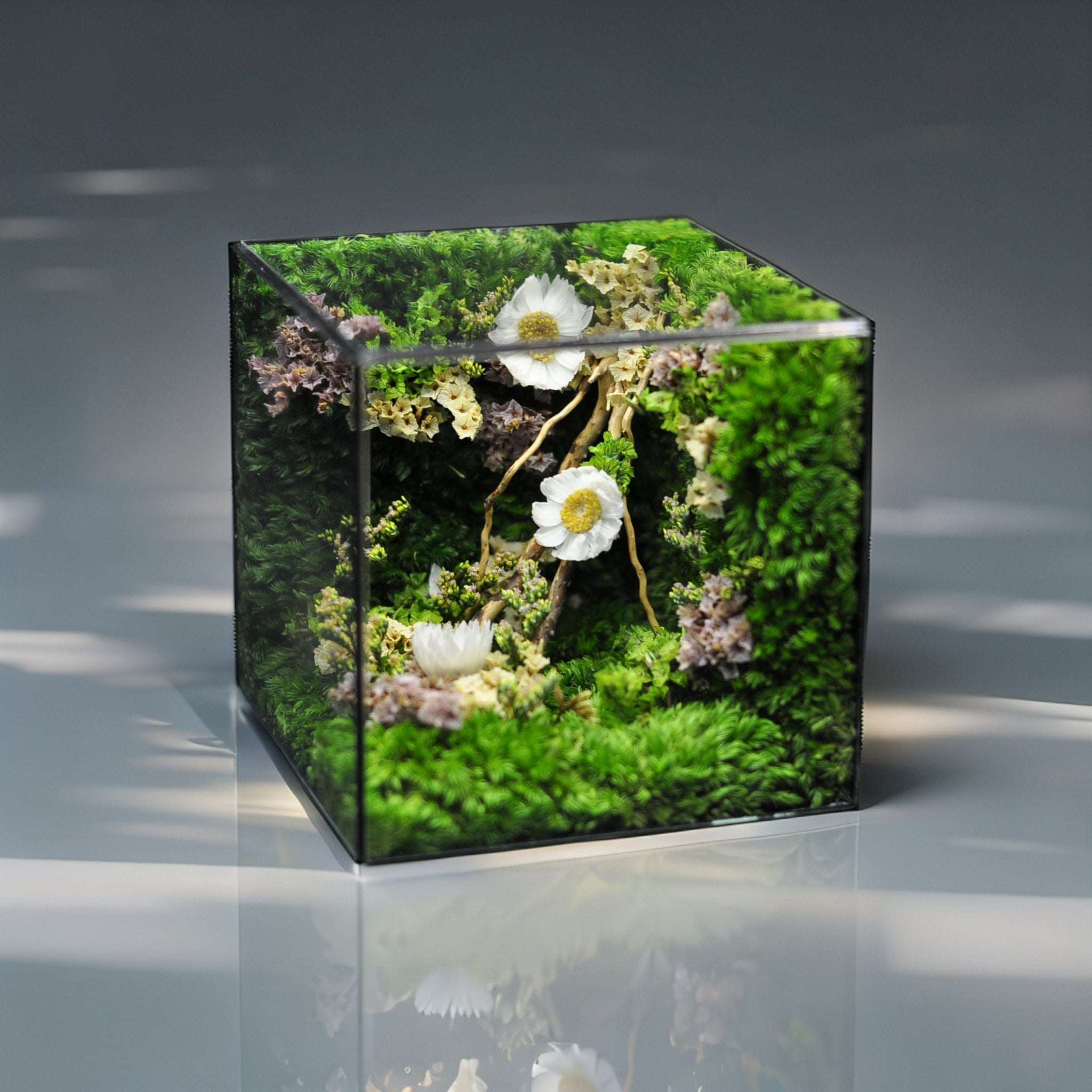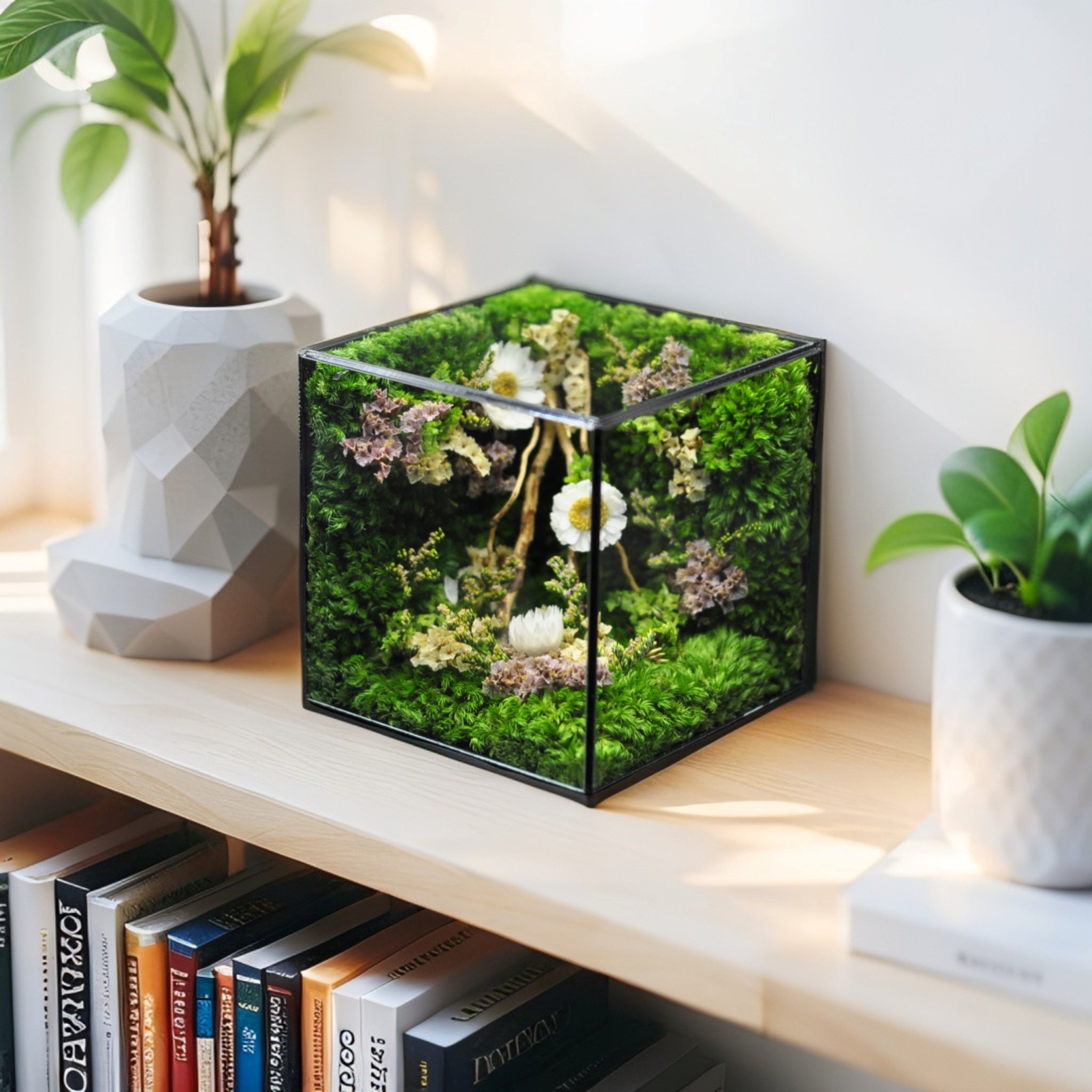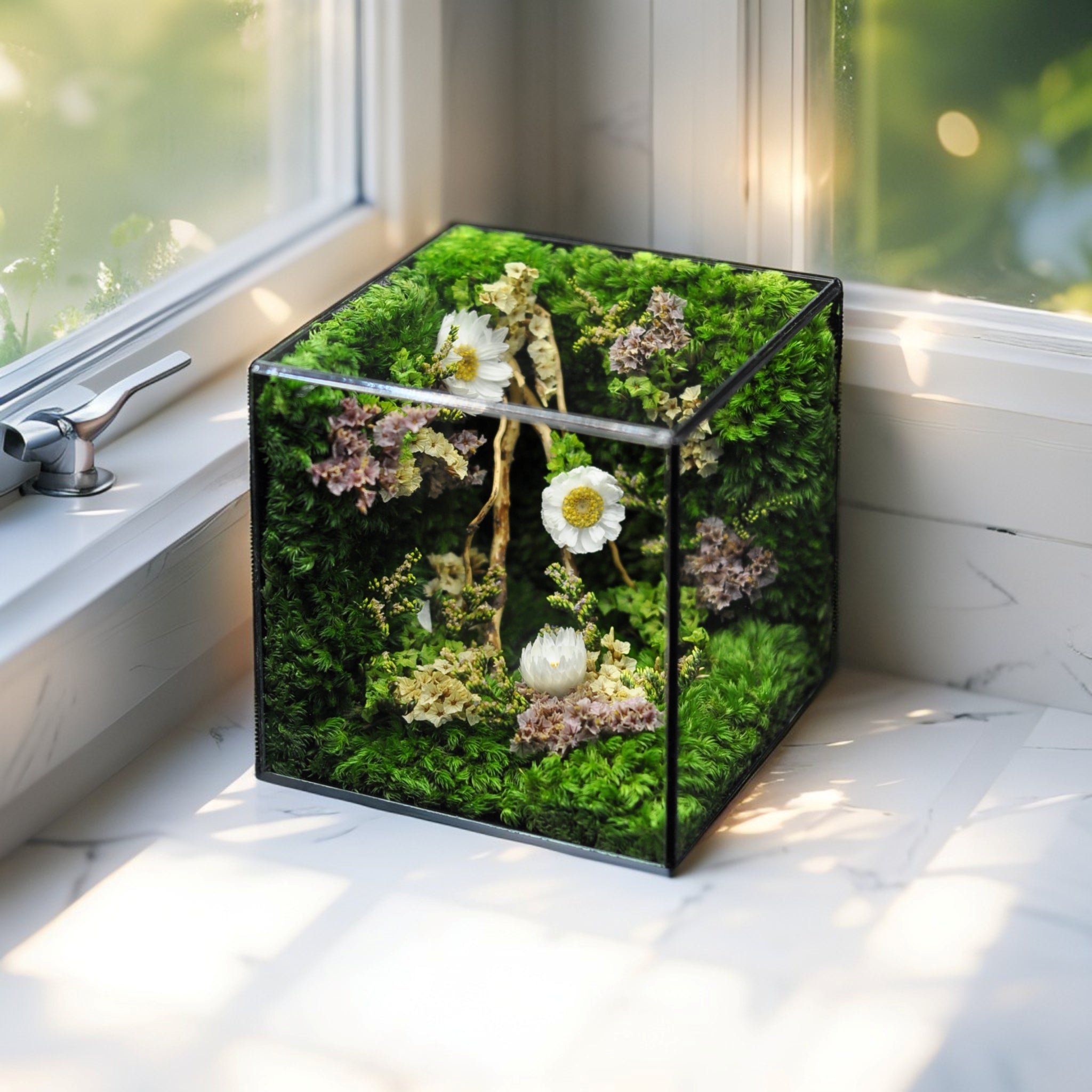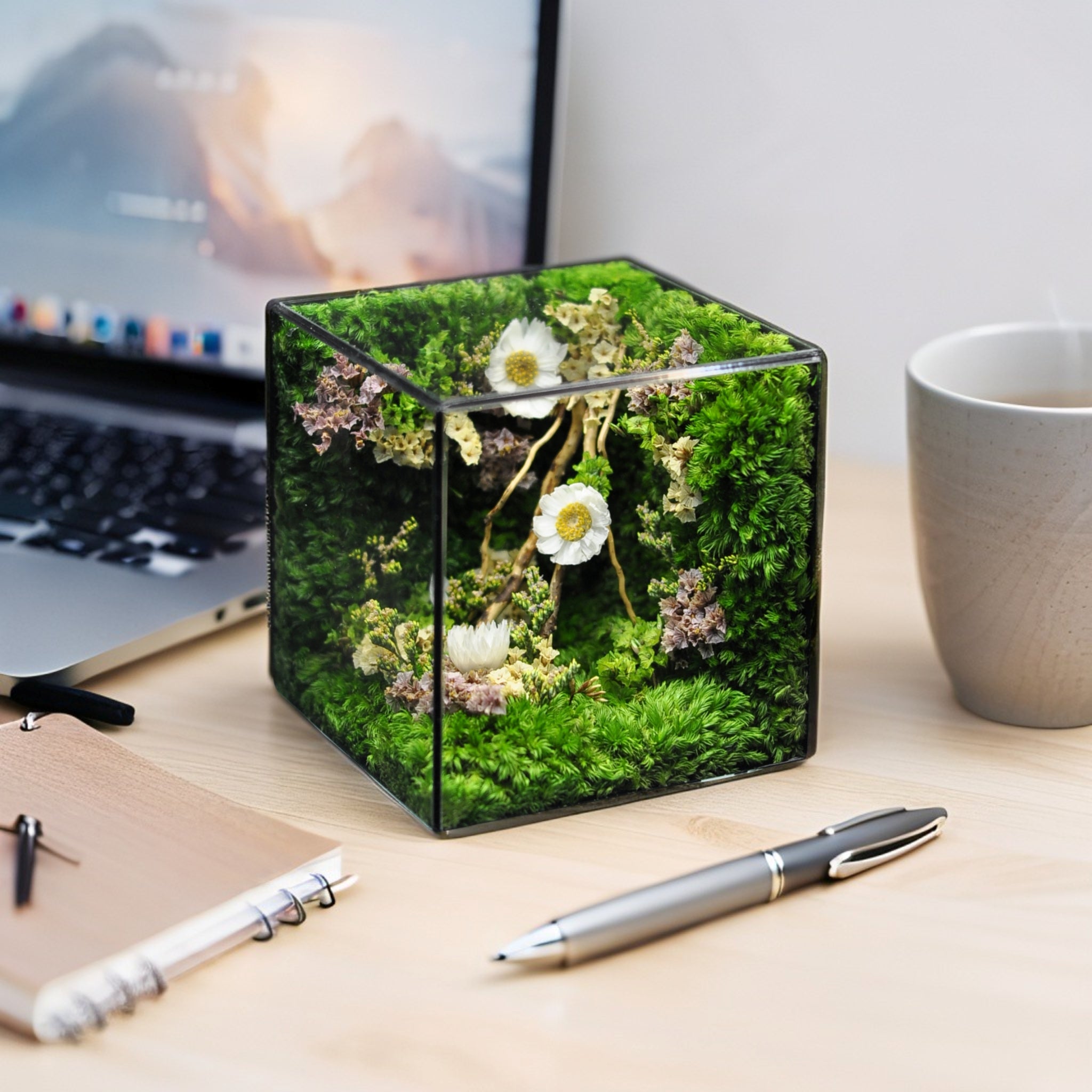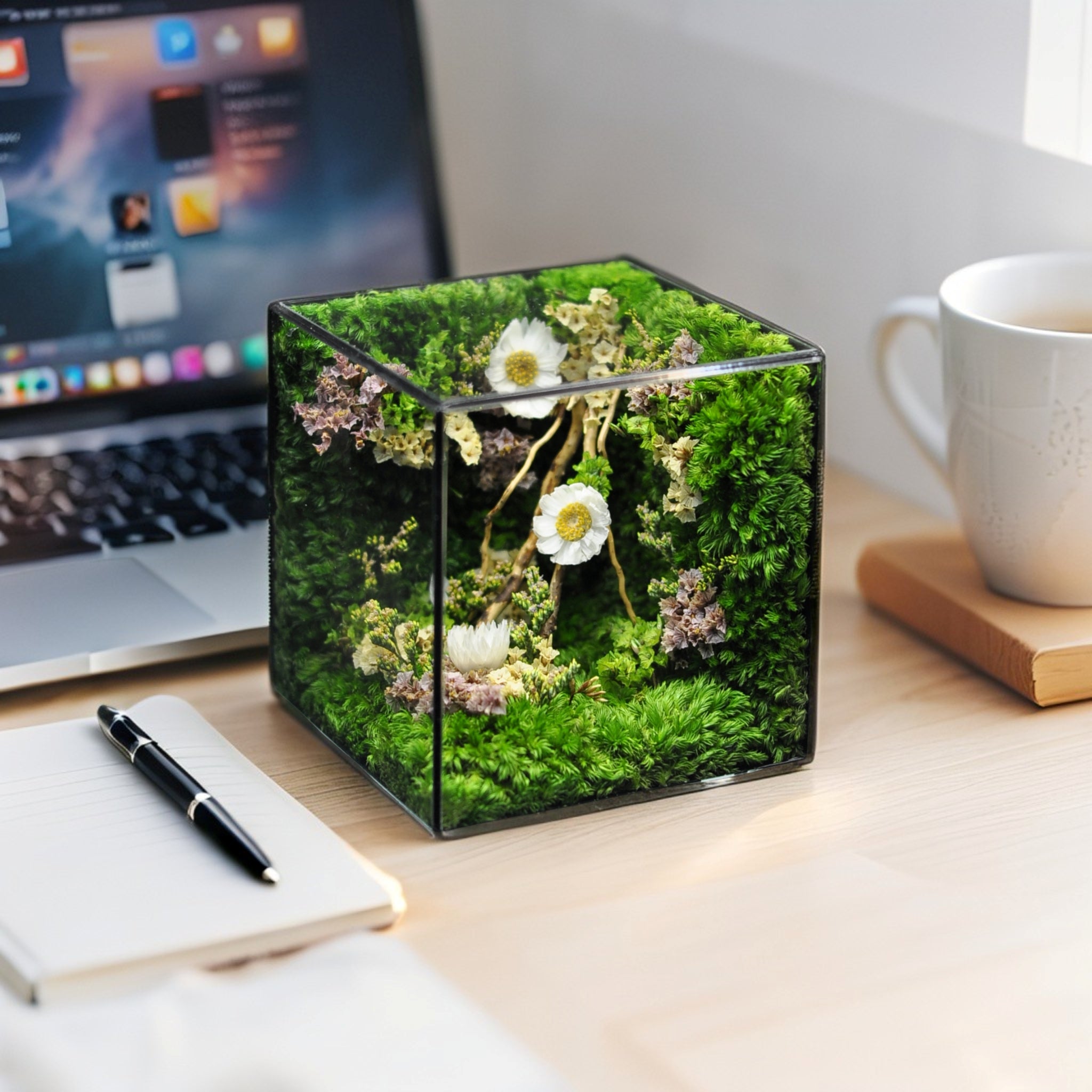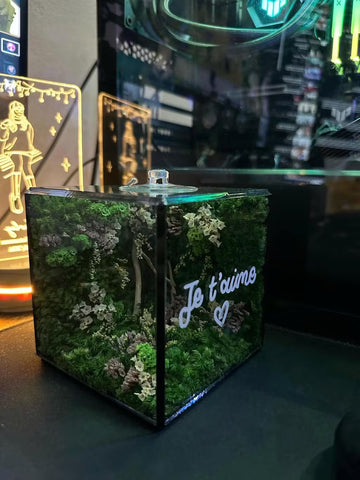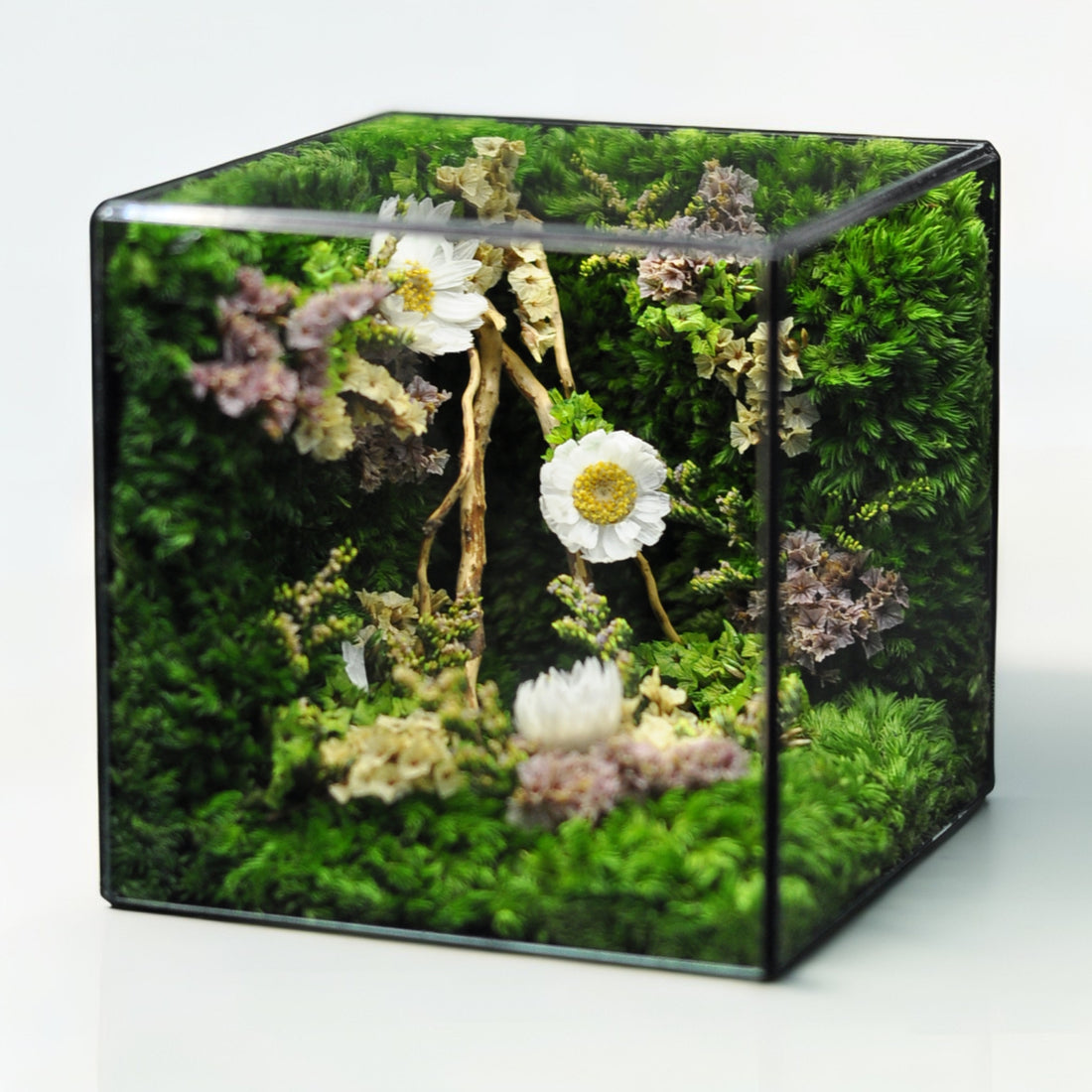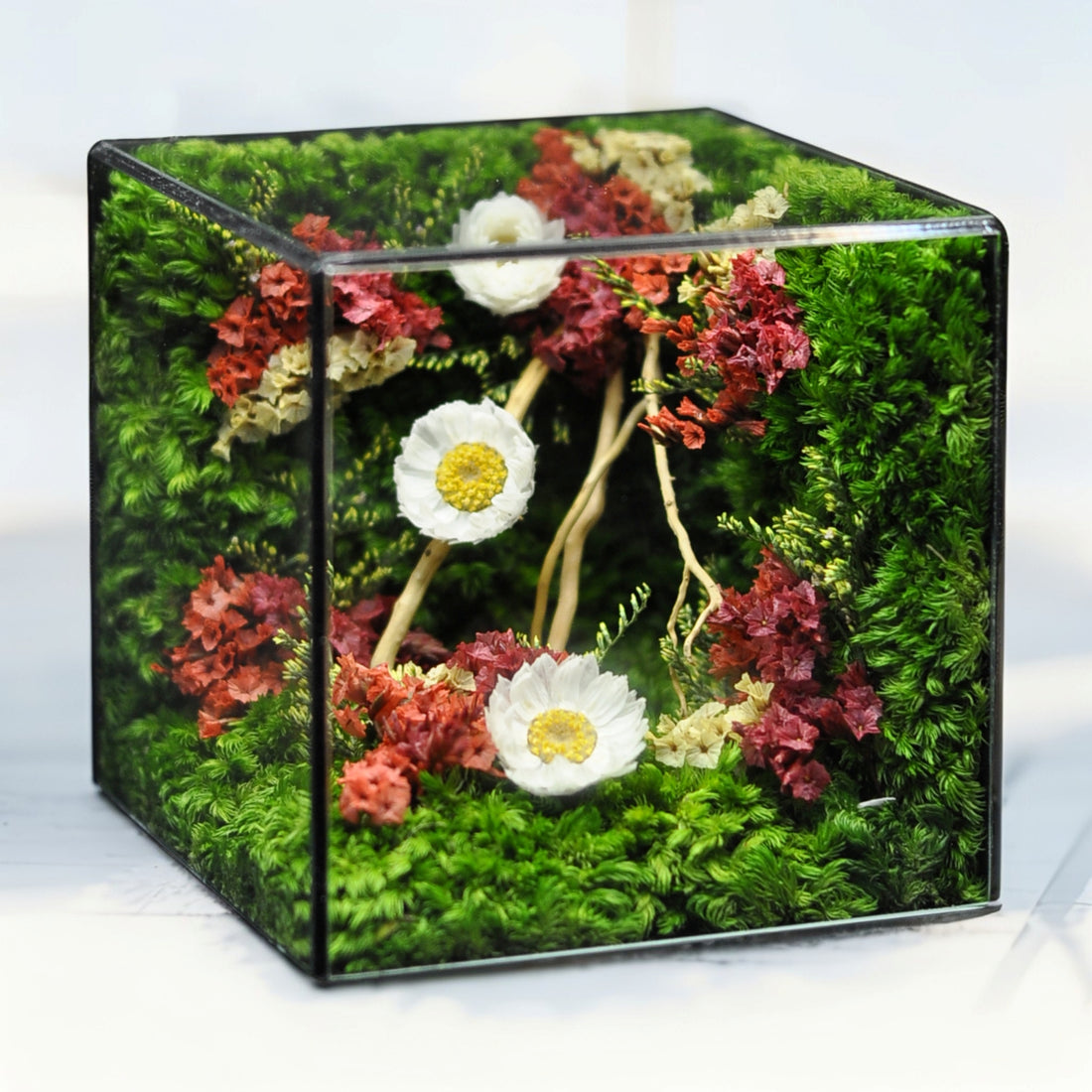Key Takeaways
Choosing the right terrarium supplies tailored to your ecosystem, budget, and maintenance goals ensures a thriving mini-garden. This expert guide goes beyond product listings—offering in-depth advice on container materials, substrate layering, lighting setups, and troubleshooting to help you create and sustain vibrant terrarium ecosystems.
- Customize supplies for every terrarium ecosystem: Align container materials, humidity needs, and plant species to ecosystem type (desert, tropical, closed) for optimal growth.
- Optimize substrate structure and composition: Layer gravel, activated charcoal, and customized soil mixes to balance drainage, aeration, moisture retention, and nutrient support.
- Select lighting that mimics natural habitats: Choose LED or fluorescent grow lights with proper spectrum and intensity based on plant requirements and container depth.
- Equip essential tools for precise assembly: Use tweezers, spray bottles, moisture meters, and humidity gauges to assemble and maintain micro-environments accurately.
- Incorporate décor for form and function: Add stones, driftwood, and moss for visual appeal while enhancing airflow, drainage, and microhabitats.
- Compare budget vs premium options: Evaluate container, substrate, and accessory options by weighing upfront cost against long-term durability and performance.
- Adopt bioactive elements for self-sustaining systems: Introduce springtails, beneficial bacteria, and leaf litter to foster nutrient cycling and reduce manual cleaning.
- Anticipate and troubleshoot common terrarium issues: Prevent mold, condensation, and overwatering by adjusting ventilation, substrate mix, and watering schedules proactively.
Armed with these insights, explore our curated budget and premium picks, step-by-step assembly instructions, and comprehensive maintenance tips to craft your perfect terrarium.
Introduction
Creating a thriving terrarium can feel like conjuring a miniature ecosystem right in your living room, but it all starts with choosing the right supplies. Did you know that the success of your tiny green paradise hinges not just on plants, but also on the specific materials, lighting, and techniques you employ? With the right combination of terrarium supplies, you can ensure your mini-garden thrives for years to come, reflecting nature's beauty in your space.
This expert buying guide is designed to empower both novice and seasoned gardeners with essential insights and recommendations. From understanding how to tailor your supplies to the unique needs of your ecosystem type to optimizing substrate and lighting, we cover everything you need to know. With our curated picks and detailed advice, you'll be well-equipped to create a stunning, self-sustaining terrarium that showcases your personal style and dedication to plant care. Let’s delve into the essentials that will elevate your terrarium experience.
Tailoring Terrarium Supplies to Your Ecosystem
Desert Terrariums: Materials, Substrate & Lighting
Desert terrariums recreate arid microclimates, where minimal humidity and bright light are key. To mimic these conditions, you’ll need open-top containers for airflow, sharply draining substrates to prevent root rot, and high-output grow lights that simulate desert sun.
- Container: open-top glass or acrylic bowls with wide mouths for ventilation and heat dissipation.
- Substrate:
- 1–2 inches of coarse gravel or LECA (lightweight expanded clay aggregate) for a stable drainage layer.
- ½ inch of coarse sand or grit to support shallow-rooted succulents.
- Lighting:
- Full-spectrum LED bulbs (5 500–6 500 K) delivering roughly 4–6 W per gallon or a PPFD of 200–400 µmol/m²/s at canopy level. Pro tip: consult manufacturer PPFD charts to dial in output.
- 10–12 hours of bright light daily; use a reflective backing to boost uniformity.
- Plant choice: low-water-need succulents such as Echeveria, Haworthia and small cacti.
Pro tip: tilt your container slightly toward the light source to ensure all sides receive even exposure. Succulents thrive in porous substrates under intense light to avoid etiolation (stretching due to low light) and root disease. Transitioning a desert setup into a moisture-rich system requires increasing substrate water retention and reducing light intensity accordingly.
Tropical Terrariums: Materials, Substrate & Lighting
Tropical terrariums favor consistent humidity and gentle air exchange. While a sealed, tall glass vessel locks in moisture, occasional ventilation prevents stagnation and mold.
- Container: tall glass cylinder or geometric vessel with a removable lid or adjustable vents.
- Substrate:
- 1 inch of hydrogranules for drainage.
- ½ inch of activated charcoal to adsorb toxins.
- Custom mix: 2 parts coconut coir or peat moss (high cation exchange capacity), 1 part orchid bark for structure, 1 part perlite for aeration.
- Lighting:
- Full-spectrum LED (5 000–6 500 K) at 3–5 W per gallon or PPFD of 150–250 µmol/m²/s.
- 12–14 hours daily; simulate dawn/dusk with a timer.
- Plant choice: ferns (Nephrolepis), bromeliads, Fittonia, small philodendrons.
Organic-rich mixes retain moisture, while perlite prevents compaction; moderate light reduces heat buildup under a closed lid. Shifting gears to sealed systems below…
Closed/Moisture-Loving Terrariums: Materials, Substrate & Lighting
Closed terrariums form self-sustaining water cycles, making them ideal for mosses and miniature epiphytes. Proper layering and low-heat light ensure long-term balance.
- Container: airtight glass jars or sealable geometric vessels.
- Substrate:
- 1–2 inches of gravel or LECA drainage layer.
- ½ inch of activated charcoal.
- 2–3 inches of custom soil mix enriched with sphagnum moss.
- Lighting:
- Low-heat full-spectrum LEDs (4–5 W per gallon or PPFD 100–150 µmol/m²/s at canopy).
- 8–10 hours daily to prevent overheating.
- Plant choice: sheet moss (Hypnum), cushion moss (Leucobryum), Pilea depressa, small ferns, miniature orchids.
Mini-ventilation tip: briefly open the lid for 10–15 minutes once a week if condensation persists. Now let’s explore container options…
Terrarium Container Types & Materials
Your container’s material and shape influence humidity control, substrate depth and visual impact. From shallow bowls to tall cylinders, choose one that complements your ecosystem and decor.
Shallow, wide vessels enhance airflow and suit desert setups; tall, narrow jars retain vertical humidity gradients in tropical and closed systems; hanging globes offer display versatility but require careful moisture management.
- Glass:
- Pros: crystal-clear view; scratch-resistant; chemically inert.
- Cons: heavy; higher cost; potential heat buildup under direct light.
- Acrylic:
- Pros: lightweight; shatterproof; affordable shapes.
- Cons: prone to scratches; can off-gas if cleaned with solvents.
- Plastic/Resin:
- Pros: budget-friendly; wide variety of colors and shapes.
- Cons: less transparency; possible chemical leaching; can warp.
- Ceramic & Stone:
- Pros: decorative finish; stable temperature.
- Cons: opaque; limits plant visibility; heavy.
For more on how shape affects performance, see Terrarium container shapes and their effects.
Substrate Layers & Soil Mix Essentials
Proper layering balances drainage, aeration, moisture retention and nutrient availability—crucial for healthy roots. Let’s break down each layer.
Drainage Layer: Gravel & Hydrogranules
- Purpose: prevents waterlogging by creating a void for excess moisture.
- Materials: pea gravel; LECA (lightweight expanded clay aggregate).
- Depth: 1–2 inches depending on vessel size.
Activated Charcoal Layer for Purification
- Role: adsorbs toxins, odors and excess minerals.
- Application: ½ inch layer directly above drainage.
- Research shows activated charcoal can adsorb up to 40% of volatile organic compounds in closed environments (Horticultural Studies Journal).
Best Substrates for Closed Terrariums & Custom Soil Mix
- Closed mix ratio:
- 3 parts coconut coir or peat moss (CEC ~60 meq/100 g)
- 1 part perlite
- 1 part fine orchid bark
- Optional handful of sphagnum moss
- Arid mix alternative:
- 2 parts coarse sand
- 1 part potting soil
- 1 part perlite
- Pre-made options: Forest Floor by Zoo Med; Exo Terra Bioactive Substrate.
Data & Evidence: Moisture Retention & Aeration Metrics
- Perlite can increase substrate porosity by up to 15% (Grower’s Quarterly).
- Vermiculite retains 3–4× its weight in water (Soil Science Review).
- Coco coir holds moisture up to 8× its weight (International Horticulture Journal).
Quantified metrics help fine-tune blends for each ecosystem.
Lighting Options & Grow Light Recommendations
Lighting drives photosynthesis and influences plant morphology. Choose fixtures that match your ecosystem’s intensity and spectrum needs.
LED vs Fluorescent: Spectrum & Intensity
- LEDs:
- Full-spectrum 400–700 nm; minimal heat.
- Lifespan ~50 000 hrs; efficiency 80–120 lm/W; PPFD 200–400 µmol/m²/s.
- Fluorescent (T5, CFL):
- Narrower spectrums; more heat near bulb.
- Lifespan ~10 000 hrs; efficiency 50–80 lm/W.
Recommendation: invest in LEDs for energy efficiency, long life and precise spectrum control.
Light Placement & Container Depth Considerations
- Shallow vessels (<6 in): 4–6 W per gallon or 200–300 µmol/m²/s.
- Deep vessels (>6 in): 6–8 W per gallon or 300–400 µmol/m²/s.
- Use reflectors or reflective tape to distribute light evenly.
Lighting Schedules & Energy Efficiency
- Desert: 10–12 hrs/day
- Tropical: 12–14 hrs/day
- Closed: 8–10 hrs/day
Quick hack: use programmable timers to simulate seasonal changes and reduce energy bills.
Essential Tools & Accessories
Having the right tools makes assembly and maintenance precise and efficient.
Assembly Tools: Tweezers, Scoops & Funnels
- Stainless-steel long tweezers for plant placement.
- Mini scoops and spoons for substrate layering.
- Funnels to add materials without dust clouds.
Pro tip: sanitize tools in a 10% bleach solution (1 part bleach to 9 parts water), rinse thoroughly and air-dry.
Maintenance Tools: Spray Bottles, Moisture Meters & Hygrometers
- Fine-mist spray bottles for gentle watering.
- Digital moisture meters to monitor substrate dampness.
- Hygrometers to track internal humidity (ideal: 60–80% RH in closed systems).
Terrarium Kit Essentials for Beginners
- Container, substrate layers (gravel, charcoal, soil mix)
- Activated charcoal, plants, décor
- Tweezers, funnel, spray bottle
- Assembling Your First Terrarium guide for step-by-step support.
Décor Elements & Plant Selection
Décor elements create microhabitats and enhance aesthetic appeal. Pair natural accents with plants suited to your ecosystem.
Moss, Stones & Driftwood for Microhabitats
- Moss types: sheet moss (Hypnum), cushion moss (Leucobryum).
- Stones: polished river rocks to anchor décor and direct airflow.
- Driftwood: inert, untreated wood for structure and moss attachment.
Plant Selection Guide by Ecosystem
- Desert: Echeveria, Haworthia, small cacti.
- Tropical: Fittonia, Nephrolepis, small bromeliads.
- Closed: Pilea depressa, maidenhair ferns, mosses.
Sourcing Moss & Décor: DIY vs Retail
- DIY: collect wild moss (check local regulations), sterilize at 180 °F for 15 minutes.
- Retail: sphagnum sheets, preserved moss packs ($5–10/pack).
Compare cost, time investment and sustainability.
Budget vs Premium Terrarium Supplies
Whether you’re on a shoestring budget or seeking designer flair, choices in containers, substrates and tools affect longevity and performance.
Containers: Economy vs Designer
- Economy: mason jars, dollar-store bowls ($3–10).
- Designer: hand-blown geometric vessels ($30–80).
Trade-off: cost vs aesthetics and durability.
Substrates & Mixes: DIY vs Pre-made
- DIY cost: coconut coir $10/5 L, perlite $8/5 L.
- Pre-made: branded bioactive mixes $20–25/20 L.
Factor in customization vs convenience.
Lighting & Tools: Price Tiers & Longevity
- Budget LED panel: ~$30; lifespan ~20 000 hrs.
- Premium LED fixture: $80–120; lifespan ~50 000 hrs.
- Tools: $5 basic tweezers vs $15 anti-corrosion; moisture meters $10 vs $30 calibrated.
Bioactive Terrarium Supplies for Self-Sustaining Systems
A well-designed bioactive terrarium harnesses microfauna and microbes to cycle nutrients and control waste.
Springtails, Isopods & Microfauna
- Springtails (Collembola): thrive at 60–80% RH and 60–75 °F; consume mold and decaying matter.
- Dwarf isopods (Porcellio scaber): tolerate 55–75% RH; shred leaf litter.
- Stocking: 50 springtails and 20 isopods per liter for a balanced cleanup crew. Monitor by placing leaf litter as bait—check recovery after 24 hrs.
Beneficial Bacteria & Fungi
- Mycorrhizal fungi powders (Great White Mycorrhizae) to enhance nutrient uptake.
- Beneficial bacterial blends (TeraGanix) for root health and disease suppression.
Leaf Litter & Nutrient Cycling
- Use sterilized oak or beech leaf litter (½ inch layer).
- Supports natural decomposition and slow nutrient release for plants and microfauna.
Common Terrarium Issues & Troubleshooting
Different ecosystems face unique challenges. Here’s how to diagnose and address common problems.
Mold & Algae: Prevention Strategies
- Desert: overwatering can lead to mold around succulents—ensure substrate dries between waterings.
- Tropical: stagnant air encourages fungal growth—ventilate weekly.
- Closed: springtails and isopods consume mold; remove excess moisture by briefly opening the lid.
Condensation Control & Ventilation Adjustments
- Excess condensation in closed jars: open lid for 30 minutes twice a week until RH falls below 80%.
- Add small vent holes (¼ inch) in lids for tropical setups.
- Use hygrometer readings to fine-tune ventilation frequency.
Watering Frequency & Schedule
- Desert: water every 2–3 weeks; allow substrate to dry fully.
- Tropical: mist every 3–5 days; deep soak once a month.
- Closed: minimal watering—check moisture meter; typically once per month.
Step-by-Step Terrarium Assembly Guide
Follow this workflow to build and maintain a thriving terrarium.
Pre-Assembly Checklist: What Supplies Are Needed to Start a Terrarium
- Container (open or closed)
- Gravel or hydrogranules
- Activated charcoal
- Custom soil mix
- Plants and décor
- Tweezers, scoops, funnel
- Spray bottle, moisture meter, hygrometer
Assembly Steps: Layering, Planting & Décor Placement
- Clean container with a 10% bleach solution (1 part bleach to 9 parts water); rinse thoroughly and air-dry.
- Add 1–2 inches of drainage layer.
- Spread ½ inch of activated charcoal.
- Build 2–3 inches of custom soil mix.
- Arrange plants with tweezers, creating gentle slopes.
- Place décor (stones, driftwood, moss).
- Lightly mist and seal or leave open based on ecosystem.
Post-Assembly Setup: Lighting, Humidity Calibration & Initial Care
- Position grow light at recommended distance; set timer per ecosystem schedule.
- Calibrate hygrometer; adjust humidity by misting or brief lid removal.
- Observe for 1–2 weeks; adjust watering and ventilation as plants settle.
Where to Buy Terrarium Supplies & Expert Brand Recommendations
Finding quality terrarium supplies online and locally ensures you get healthy plants and reliable materials.
Top Online Retailers: Where to Buy Terrarium Supplies Online
- Amazon: best terrarium supplies for broad selection.
- Etsy for artisanal glass containers and DIY kits.
- The Greenhouse People for specialized bioactive materials.
- Brands: Exo Terra, Arcadia, Zoo Med.
Specialty Stores & Local Gardening Centers
- Independent nurseries for organic substrates, live moss and exotic plants.
- Big-box stores (Home Depot, Lowe’s) for basic gravels and terrarium kit essentials.
Pro tip: ask staff for pesticide-free soil and inspect plant health before purchase.
Expert Insights & Case Study
Real-world examples and professional tips deepen your understanding and help avoid common pitfalls.
Case Study: Building a Bioactive Tropical Terrarium
- January 2023, Chicago plant studio built a 10-gallon closed tropical terrarium.
- Substrate: 2 in coir/bark/perlite mix with ½ in charcoal.
- Fauna: 200 springtails, 50 isopods.
- After 6 months: stable 75% RH; no mold; ferns grew 20% taller.
- Key lesson: balanced microfauna populations are critical for waste breakdown and plant vigor.
Case Study: Rescuing a Desert Terrarium from Root Rot
- Home enthusiast in Arizona noticed yellowing leaves 4 weeks after planting succulents in a closed jar.
- Diagnosis: overcompacted substrate and poor drainage.
- Intervention: replaced soil with a grit-based arid mix; increased light exposure by 2 hours.
- Outcome: new growth appeared in 3 weeks; substrate remained dry between waterings.
- Takeaway: substrate porosity and ventilation are vital in arid setups.
Expert Tips for Long-Term Success
- Rotate lighting schedule seasonally to mimic natural day length.
- Partially refresh substrate every 12–18 months by adding fresh coir or grit.
- Inspect monthly for pests; isolate affected plants promptly.
- Sterilize tools between maintenance to prevent cross-contamination.
- Test substrate pH (ideal 5.5–6.5) quarterly using soil test kits.
By selecting the right terrarium supplies and following these expert recommendations, you’ll cultivate a vibrant, self-sustaining mini-ecosystem.
Conclusion
Successfully crafting a terrarium is an art that balances the specific needs of chosen plants with the proper materials, substrate layering, and environmental conditions. From the arid environments of desert terrariums requiring sharp drainage, to the moisture-rich tropics demanding consistent humidity, our exploration of ecosystems reveals that careful selection and strategic assembly are crucial for vibrant growth. Additionally, utilizing expert-recommended tools and addressing common issues can enhance long-term success.
Understanding these foundational principles not only enriches your gardening experience but fosters an appreciation for sustainable mini-ecosystems in your space. As you embark on your terrarium journey, consider experimenting with various setups and plant combinations to discover unique environments that thrive under your care. What will your next terrarium project look like, and how will you tailor it to reflect your personal style and commitment to plant health?
Frequently Asked Questions (FAQ)
Q: What supplies do I need to start a terrarium?
A: To start a terrarium, you need a suitable container (open or closed), a drainage layer (gravel or hydrogranules), ½ inch of activated charcoal, a custom soil mix, plants and décor, plus tools such as tweezers, mini scoops, a funnel, a spray bottle, a moisture meter, and a hygrometer.
Q: How do I choose the right substrate for my terrarium?
A: Select 1–2 inches of gravel or LECA for drainage, add ½ inch of activated charcoal, then build an ecosystem-specific soil mix: for closed terrariums use 3 parts coconut coir or peat moss, 1 part perlite, 1 part orchid bark (optional sphagnum moss); for arid setups use 2 parts coarse sand, 1 part potting soil, 1 part perlite.
Q: What type of lighting is best for indoor terrariums?
A: Full-spectrum LED lights are recommended for efficiency and low heat. Match intensity to your ecosystem: desert terrariums need 4–6 W per gallon (PPFD 200–400 µmol/m²/s), tropical setups 3–5 W per gallon (PPFD 150–250 µmol/m²/s), and closed systems 4–5 W per gallon (PPFD 100–150 µmol/m²/s).
Q: How often should I water my terrarium?
A: Watering schedules vary by ecosystem: desert terrariums every 2–3 weeks; tropical terrariums mist every 3–5 days with a deep soak once a month; closed terrariums require minimal watering—typically once per month or as indicated by a moisture meter.
Q: What container types and materials are suitable for different terrarium ecosystems?
A: Desert terrariums work best in open-top glass or acrylic bowls, tropical setups suit tall glass cylinders with vents, and closed terrariums use sealable glass jars or geometric vessels. Glass is clear and inert, acrylic is lightweight and shatterproof, plastic/resin is affordable but may leach, and ceramic/stone is decorative but opaque.
Q: How can I prevent mold and algae growth in my terrarium?
A: Prevent mold and algae by matching ventilation and fauna to your ecosystem: ensure desert substrates dry fully between waterings, ventilate tropical terrariums weekly, and in closed systems introduce springtails and isopods and briefly open the lid to reduce excess moisture.
Q: What tools are essential for building and maintaining a terrarium?
A: Essential assembly tools include stainless-steel long tweezers, mini scoops, and funnels; maintenance tools include fine-mist spray bottles, digital moisture meters, and hygrometers. Tools can be sanitized in a 10% bleach solution, rinsed, and air-dried before use.




